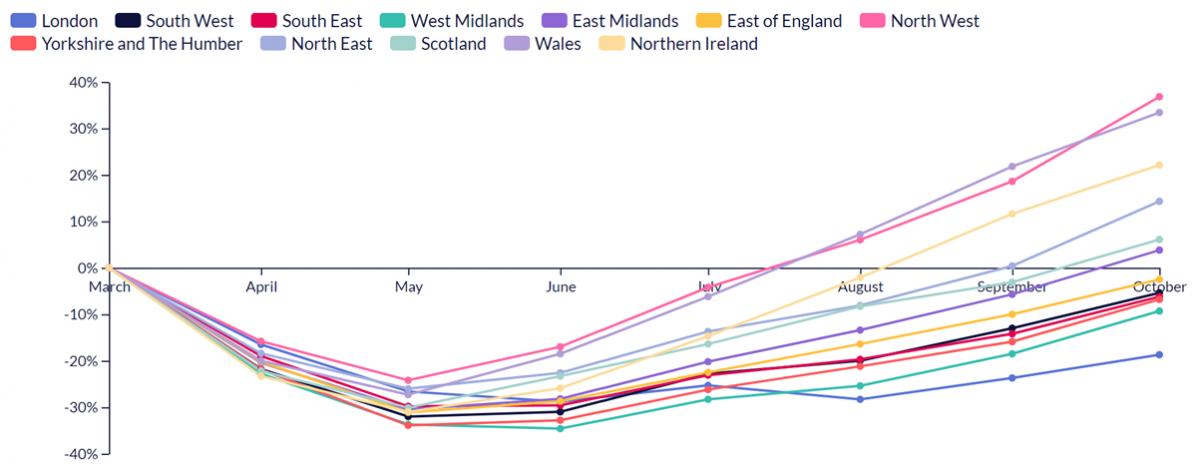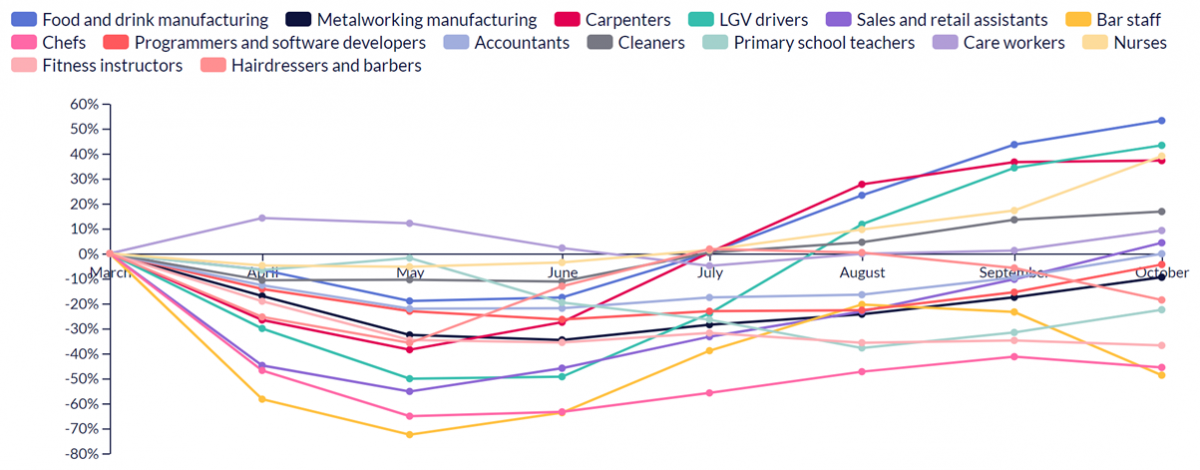- 1.36 million active job adverts in the UK in first week of November, passing levels seen in early March
- Six of the 12 nations and major regions now have higher numbers of job adverts than in March, while six still have fewer
- Recovery led by north-west England and Wales, but London lags behind
- Roles in construction, logistics and food and drink have recovered strongly, while hospitality and leisure remain at significantly lower levels than in March
In the first week of November, as the new England-wide lockdown was introduced, there were 1.36 million active job postings in the UK. This is the first time that figure has been passed since the second week of March, just before the first lockdown was announced. However, as the REC’s latest Jobs Recovery Tracker highlights, this recovery has not been evenly distributed across the different regions and sectors of the UK labour market.
Job adverts in north-west England recovered at the quickest rate, passing their March levels in early August, with Wales not far behind. In October, six of the 12 nations and major regions of the UK had recorded higher numbers of active job adverts than in March, led by north-west England (+36.8%), Wales (+33.4%) and Northern Ireland (+22.1%).

However, six regions of England continue to record lower numbers of active job postings than March. London’s labour market is lagging furthest behind, with 18.7% fewer job adverts than March, followed by the West Midlands (-9.3%) and Yorkshire & the Humber (-6.8%).
Neil Carberry, Chief Executive of the REC, said:
“Unemployment and redundancy numbers earlier this week showed that this is a tough moment for our jobs market. But we also know that there are always jobs being created by those businesses who can, and as this data reveals, there is hope to be found in many places and sectors. What we need to do now is support businesses who can to create jobs, and help people who have lost work to transition into those new roles. With the stark difference in demand across different regions, avoiding a skills mismatch will require serious planning. Recruiters, with their intimate local and sectoral knowledge, can play a central role in this effort.
“Government can also help by reducing barriers to creating jobs through tax policy and regulatory change – like keeping the online right-to-work checking we have moved to in the pandemic. Broadening the apprenticeship levy would also allow workers to train and fill skill gaps in the longer-term. Some hard-pressed sectors with high demand – like food manufacturing – also need the new immigration system to reflect the severe shortages they are facing.”
More must be done to avoid a skills mismatch in different sectors and regions
Six months on from when the Jobs Recovery Tracker started tracking hiring hotspots during the pandemic, the analysis has also identified discrepancies in how occupations in different sectors have recovered. Job postings for care workers have remained at a relatively stable level from March to October, due to heightened demand for staff in care homes. By October, the number of adverts for nurses had increased to 39.0% above the level of March, in preparation for a tough winter ahead.
After significant falls in the spring, roles in construction, logistics and food and drink manufacturing have also seen notable growth in postings through the summer and autumn. The number of adverts for food and drink processing operatives (+53.2%) and LGV drivers (+43.3%) significantly increased as we headed into the winter. Seasonal demand will also have affected these numbers, as the retail sector prepared for Halloween, Black Friday and Christmas.
There have also been rising job adverts for carpenters (+37.2%) and other construction occupations as the sector opened up through the summer. And while job postings for skilled, white collar occupations like software developers and accountants fell during the first months of the pandemic, demand has recovered and there are now around the same level as we saw in March.

At the other end of the spectrum, it is no surprise to see that roles in hospitality and leisure have fared the worst over the past eight months. In October there were 48.7% fewer adverts for bar staff than in March, despite a notable recovery during the summer months. Job postings for chefs (-45.6%) and fitness instructors (-36.8%) also remain significantly lower than before the pandemic hit the UK.
With unemployment levels rising across the country but demand varying significantly by sector, many people will need help transitioning into a new role or industry. Recruiters can provide vital support, helping with CV writing, highlighting transferrable skills and opening both candidates’ and employers’ eyes to what is available.
Matthew Mee, Director, Workforce Intelligence at Emsi said:
“I wholly agree with Neil’s comments – particularly the urgent need for focus on re-skilling parts of the workforce to enable speedy transition into sectors that are in growth mode. With discussion this week around a potential Covid vaccine coming closer to fruition, and the rise in confidence this brings, it will be interesting to see how this impact hiring activity in coming weeks.
“One of the most interesting developments we are seeing in terms of employer demand is the ‘London Lag’, which is seeing the capital return to pre-Lockdown levels at a much slower rate than other regions of the country. Whereas the likes of the North West and Wales in particular have seen job postings rise considerably since May, London has been much flatter and is still well below the volume seen in March. When we couple this with the fact that furlough take-up has been higher in London than elsewhere, and that the highest rise in Claimant Counts has been in the London commuter belt, it seems that the restrictions since March may well have had a greater proportionate impact on the capital than on other regions of the country.”







